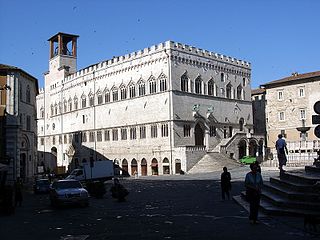
Montalcino is a hill town and comune in the province of Siena, Tuscany, central Italy.

Simone Martini was an Italian painter born in Siena. He was a major figure in the development of early Italian painting and greatly influenced the development of the International Gothic style.

San Gimignano is a small walled medieval hill town in the province of Siena, Tuscany, north-central Italy. Known as the Town of Fine Towers, San Gimignano is famous for its medieval architecture, unique in the preservation of about a dozen of its tower houses, which, with its hilltop setting and encircling walls, form "an unforgettable skyline". Within the walls, the well-preserved buildings include notable examples of both Romanesque and Gothic architecture, with outstanding examples of secular buildings as well as churches. The Palazzo Comunale, the Collegiate Church and Church of Sant' Agostino contain frescos, including cycles dating from the 14th and 15th centuries. The "Historic Centre of San Gimignano" is a UNESCO World Heritage Site. The town also is known for saffron, the dry aged and saffron infused Golden Ham, pecorino cheese and its white wine, Vernaccia di San Gimignano, produced from the ancient variety of Vernaccia grape grown on the sandstone hillsides of the area.

Città di Castello ; "Castle Town") is a city and comune in the province of Perugia, in the northern part of Umbria. It is situated on a slope of the Apennines, on the flood plain along the upper part of the river Tiber. The city is 56 km (35 mi) north of Perugia and 104 km (65 mi) south of Cesena on the motorway SS 3 bis. It is connected by the SS 73 with Arezzo and the A1 highway, situated 38 km (23 mi) west. The comune of Città di Castello has an exclave named Monte Ruperto within Marche.

The Collegiata di Santa Maria Assunta or Duomo di San Gimignano is a Roman Catholic collegiate church and minor basilica in San Gimignano, in Tuscany in central Italy. It contains important cycles of Renaissance frescoes by artists including Domenico Ghirlandaio, Benozzo Gozzoli, Taddeo di Bartolo, Lippo Memmi and Bartolo di Fredi. It falls within the UNESCO World Heritage Site of the "Historic Centre of San Gimignano", with its frescoes being described by UNESCO as "works of outstanding beauty".

Benozzo Gozzoli was an Italian Renaissance painter from Florence. A pupil of Fra Angelico, Gozzoli is best known for a series of murals in the Magi Chapel of the Palazzo Medici-Riccardi, depicting festive, vibrant processions with fine attention to detail and a pronounced International Gothic influence. The chapel's fresco cycle reveals a new Renaissance interest in nature with its realistic depiction of landscapes and vivid human portraits. Gozzoli is considered one of the most prolific fresco painters of his generation. While he was mainly active in Tuscany, he also worked in Umbria and Rome.

Spello is an ancient town and comune (township) of Italy, in the province of Perugia in eastern-central Umbria, on the lower southern flank of Monte Subasio. It is 6 km (4 mi) NNW of Foligno and 10 km (6 mi) SSE of Assisi. It is one of I Borghi più belli d'Italia.

Montefalco is a historic small hill town in Umbria, Italy, with a population of 5,581 in August 2017. It has been settled since pre-Roman times, and retains many of its historic buildings. From 1446 to 1861 it was part of the Papal States. It is one of I Borghi più belli d'Italia.

Pienza is a town and comune in the province of Siena, Tuscany, in the historical region of Val d'Orcia. Situated between the towns of Montepulciano and Montalcino, it is considered the "touchstone of Renaissance urbanism".

Poggibonsi is a town in the province of Siena, Tuscany, Central Italy. It is located on the River Elsa and is the main centre of the Valdelsa Valley.

Coppo di Marcovaldo was a Florentine painter in the Italo-Byzantine style, active in the middle of the thirteenth century, whose fusion of both the Italian and Byzantine styles had great influence on generations of Italian artists.

Lippo Memmi was an Italian painter from Siena. He was the foremost follower of Simone Martini, who was his brother-in-law.

The Palazzo dei Priori or comunale is one of the best examples in Italy of a public palace from the communal era. It is located in the central Piazza IV Novembre in Perugia, Umbria. It extends along Corso Vannucci up to Via Boncambi. It still houses part of the municipality, and, on the third floor, the Galleria Nazionale dell'Umbria. It takes its name from the Priori, the highest political authority governing the city in the medieval era.
Palazzo del Podestà is Italian for "Palace of the Chief Magistrate" of a town.

Pier Francesco Fiorentino was a 15th-century painter active in San Gimignano for much of his mature life, depicting religious-themed subjects.

The Church of Santa Maria dei Servi is a Romanesque style, Roman Catholic church in the Terzo of San Martino in the city of Siena, Tuscany, Italy.

The Palazzo Pretorio is a historical building in Prato, Tuscany, Italy. It was the old city hall, standing in front of the current Palazzo Comunale. It now accommodates the Civic Museum of Prato, which was reopened in September 2013.

Memmo di Filippuccio was a 14th-century painter from Siena, Italy.

Piazza del Duomo is a city square in San Gimignano, Italy.

The Palazzo degli Anziani also known as the Palazzo del Comune, della Comunitá or del Giano is a Gothic-style stone palace located in the ancient historic center of Pistoia, Tuscany, Italy. The palace served as city hall for centuries; it still belongs to the comune and now mainly houses the Museo Civico d'Arte Antica.






















